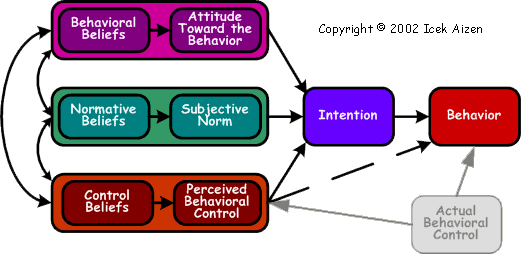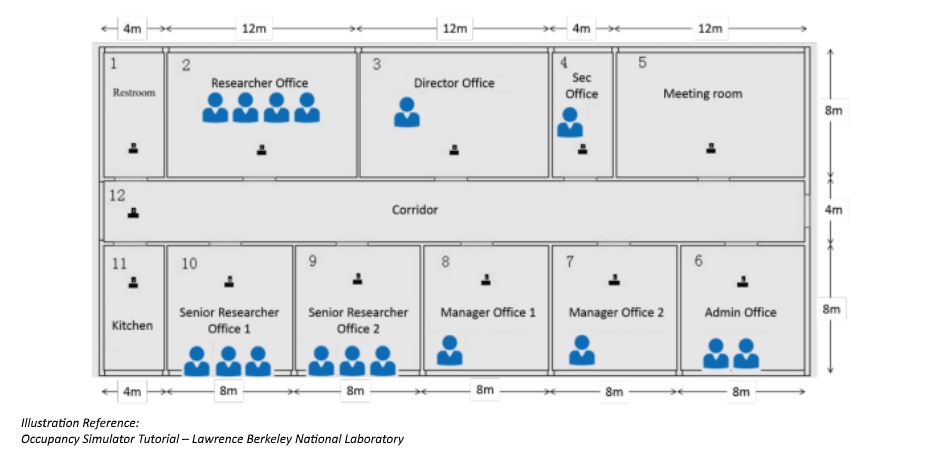Modeling Occupant Behavior
The current approach in building design focuses almost solely on increasing energy efficiency by improving system-oriented controls and behavior. However, occupant behavior also affects energy efficiency. To provide a more realistic modeling result, occupant behavior needs to be included in energy modeling.
Energy-related occupant behavior can be defined as functions such as adjusting thermostats and humidistats, switching main and task lights on and off, opening and closing operable windows or window blinds, turning personal heaters or fans on and off, etc.
Research1 shows occupant behavior can affect energy consumption even more than technological advancements for systems. In one study,1 researchers audited a few buildings in a hot and dry climate that showed unexpected higher energy consumption during non-operating hours than operating hours due to the occupant behavior.
Lee2 coupled EnergyPlus and agent-based modeling platforms to simulate occupant behavior (based on the reasoned action model theory3) within an energy model. He stated that “The agent-based modeling approach for simulating occupant behaviors has shown that uncertainties of occupant behaviors can be accounted for and simulated, lending the potential to augment existing simulation methods.”2

Conceptual Model. Source: Ajzen, I. (1991). The theory of planned behavior. Organizational Behavior and Human Decision Processes, 50, p. 179-211.
Occupant behavior has been modeled by software (e.g., agent-based modeling) to “simulate the diffusion of energy saving ideas through social networks within a building,4 predict user-controlled plug loads,5 and it has allowed realistic representations of occupants’ adaptive responses to changing comfort conditions.6,7
Figueroa, et al.7 analyzed a selected building energy model where they used EnergyPlus as the modeling tool and a (1) standard assumption method along with two improved and more sophisticated methods of (2) Markov chain modeling and (3) agent-based modeling to evaluate the effect of these three methods on accuracy of the energy model outcome where each has been used to model the occupants’ behavior in their own ways.
Their preliminary findings were “(1) better occupancy data greatly improves energy model accuracy, (2) standard assumptions about occupant schedules are often wrong so that a more sophisticated representation is warranted, (3) better data about occupants’ adaptive responses only marginally improves energy model accuracy, (4) yet such data are quite valuable for predicting occupant satisfaction, and (5) incorporating occupancy data EnergyPlus needs additional hooks for incorporating occupant behavior.”7
One comprehensive effort under the umbrella of IEA- EBC (International Energy Agency–Energy in Buildings and Communities Programme) Annex 66 is an ongoing research project (2013 to 2017) with the specific objective to quantify, simulate and demonstrate the occupant behavior effect on building energy consumption. Related information and publications can be found at www.annex66.org.
In the current professional approach, one main shortfall is that when performing energy modeling there is a lack of capability of capturing the dynamic nature of occupant behavior. Using scheduling and diversity factors is not sufficient to answer this need. Occupants in a building are not just identical dummies generating an average sensible and latent heat with no active capability in controlling their environment.
A better solution for simulation should be developed for the modeling professional simulating building energy consumption. That would allow considerations of behavior, decision-making and interaction of occupants with each other and the environment, as well as the current and only assumption of their passive presence in the building.
Such advancements would allow for energy models with higher accuracy and, therefore, pave the road for designers to adjust their design considerations to conserve higher levels of energy. The advancement in computing capabilities, software accessibility and knowledge means that these models may be available in the not too distant future.
To begin, we simply need to develop proper action and interaction rules between occupants and building control systems based on the level of comfort and consciousness of individuals and groups,2 implement these behaviors in software such as agent-based modeling as Lee2 did, and couple this software with our energy modeling tools. Therefore, these software programs can operate in parallel. Each time an individual agent reacts to the environment setting (either by readjusting the setting, or by supplemental actions such as running personal fans or heaters), the energy modeling software can pick up the new environment conditions for continuation of energy modeling.
Even further, as the leaders in the building and energy industry, we should look at our current energy modeling software and improve them so there are easy ways for integrating them with other software tools. EnergyPlus is one of the few that has a platform that allows coupling of its energy modeling process with external software at some limited level. Even though it is the choice of academic researchers for energy modeling, it is rarely used by design professionals for this purpose. We have much to do, and we better get to work soon to improve our current approaches.
REFERENCES
- Masoso, O.T., L.J. Grobler. 2010. “The dark side of occupants’ behaviour on building energy use.” Energy and Buildings
42(2):173 – 177. - Lee, Y. S. 2013. “Modeling Multiple Occupant Behaviors in Buildings for Increased Simulation Accuracy: An Agent-Based Modeling Approach.” Doctoral dissertation, University of Pennsylvania.
- Azjen, I., T.J. Madden. 1986. “Prediction of goal-directed behavior: Attitudes, intentions, and perceived behavioral control.” Journal of Experimental Social Psychology 22(5):453 – 474.
- Chen, J., J.E. Taylor, H.H. Wei. 2012. “Modeling building occupant network energy consumption decision-making: The interplay between network structure and conservation.” Energy and Buildings 47(April):515 – 524.
- Zhang, T., P.O. Siebers, U. Aickelin. 2011. “Modeling electricity consumption in office buildings: An agent based approach.” Energy and Buildings 43(10):2882 – 2892.
- Andrews, C.J., D. Yi, U. Krogmann, J.A. Senick, R.E. Wener. 2011. “Designing buildings for real occupants: an agent-based approach.” IEEE Transactions on Systems, Man, and Cybernetics—Part A: Systems and Humans 41(6):1077 – 1091.
- Figueroa, M., H.C. Putra, C.J. Andrews. 2014. “Preliminary Report: Incorporating Information on Occupant Behavior into Building Energy Models.” Prepared by the Center for Green Building at Rutgers University for the Energy Efficient Buildings Hub.
IMAGES
- header image: Lawrence Berkeley National Laboratory, 2016, Occupancy Simulator Tutorial, https://occupancysimulator.lbl.gov/OSim_Tutorial.pdf.
- conceptual model: Theory of Planned Behavior/Reasoned Action, Conceptual Model, viewed 14 October 2016, https://www.utwente.nl.
“Modeling Occupant Behavior” was published in the October 2016 edition of the ASHRAE Journal.
Author: Javad Khazaii, PhD, PE

